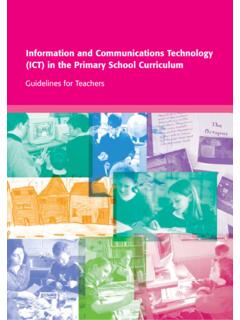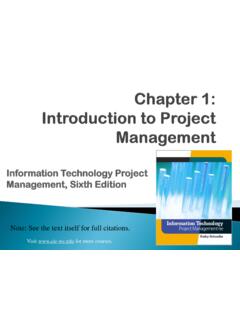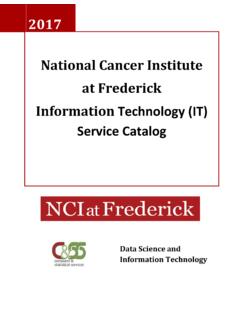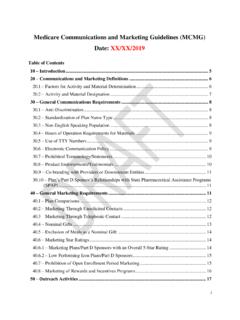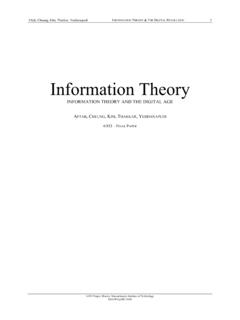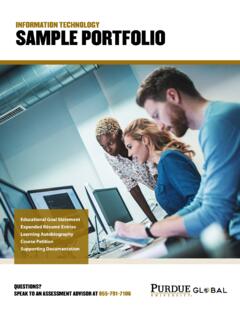Transcription of Effects of Information and Communication Technology ...
1 ArticleEffects of Information and Communication Technology (ICT) on Students Academic Achievement and Retention in Chemistry at Secondary LevelIshtiaq HussainKohat University of Science & SulemanInstitute of Education & Research Kohat University of Science & M. Naseer ud DinAssistant Professor, Institute of Education & Research Kohat University of Science & Technology Shafique Kohat University of Science & current paper investigated the Effects of Information and Communication Technology on the students academic achievement and retention in chemistry. Fifty students of 9th grade were selected randomly from Kohsar Public School and College Latamber Karak. The students were grouped into equivalent groups based on pretest score.
2 In order to collect data, pretest posttest equivalent groups design was used. Mean, standard deviation and independent 73 Vol. 4 No. 1 (June 2017)Journal of Education and Educational Developmentsamples t-test were applied through SPSS for data analysis. Based on statistical analysis, it came to light that Information and Communication Technology positively affects students academic achievement and retention and ICT was found more compelling, effective and valuable in teaching of chemistry when contrasted with conventional techniques of teaching. It is recommended that Information and Communication Technology should be used in teaching chemistry for enhancing students academic achievement at secondary : academic achievement, chemistry, Information and Communication Technology (ICT), retention, secondary levelIntroductionInformation and Technology has a major role to play in forming the new worldwide economy to deliver fast changes in the society.
3 Within the previous decade, ICT has advanced and changed at such a speed, that developing countries have not been able to catch up with the revolution and have been left behind and thus lag in their Communication with the developed countries. ICT acts as the foundation stone of the contemporary world; thus, understanding this Technology and its fundamental concepts is considered as part of the core of education (UNESCO, 2002). Technology has the potential to renovate the ways of instruction, where and how learning occurs and the roles of students and educators in the instructional process (UNESCO, 2002a). ICT is transforming procedures of instructional process by contributing components of strength to learning situations involving virtual environment.
4 It is an effective Vol. 4 No. 1 (June 2017)74 Effects of Information and Communication Technology (ICT)and influential instrument for providing educational opportunities; thus, it is difficult to envision future learning situations that are not bolstered by Information and Communication institutions may utilize ICT to enrich the students with skills and knowledge for the 21st century (Andoh, 2012), such that it can add to worldwide accessibility to education, educational equality, broadcasting of quality teaching learning programs, educators professional growth and to help in obtaining a more effective educational management. Hence, accessibility, inclusion and standard being the key issues of education, can be comfortably addressed through ICT.
5 ICT improves the standard of education by encouraging learning through ongoing discussion, delayed time discussion, directed instruction, self-learning, critical thinking, data seeking and analysis (Yuen, Law & Wong, 2003). Utilization of ICT can enhance outcomes, instruction, administration and create important abilities in the underprivileged groups (Sharma, 2003), and at the same time influence educational instruction and research process (Yusuf, 2005).In classroom teaching and learning process, the use of ICT is imperative as it gives chance to the instructors and learners to operate, store, control and retrieve data other than to promote self-regulated and active learning (Ali, Haolader & Muhammad, 2013).
6 ICT-based learning includes an expanded propensity towards collaborative learning among learners and instructors, not just in a specific classroom. This kind of collaboration is in contrast to the conventional learning environment, for example, distance learning inspires educators and learners to engage in learning even after school time (Ali, Haolader & Muhammad, 2013). The system helps Vol. 4 No. 1 (June 2017)75 Hussain, Suleman, Din & Shafiqueinstructors to plan and prepare lessons and design materials such as course content (Ali, Haolader & Muhammad, 2013).The rapid development of this system has prompted a revolution in learning as new technological advancement in education has involved the re-examination of new techniques and instruments in instructional and the Internet have been touted as potentially capable means to empower the users for educational changes and improvement, by utilizing various Information and resources and reviewing Information from different points of view; hence, cultivating the authenticity and actuality of learning situations (Tinio, 2003).
7 ICT helps to make complicated things simple to comprehend by simulations that once more add to real learning situations. Hence, ICT may act as a facilitator of dynamic learning and higher order thinking (Alexander, 1999).To enhance the academic performance of students, there is a need to turn from conventional teaching methods to modern teaching methods. Computer Assisted Instruction (CAI) is space and time independent making it convenient for students to go through the program either at home or on a school computer. This encourages interactivity, which individualizes content for each learner based on their needs and it provides formative feedback to multiple choice questions.
8 CAI enhances learning rate where the learners are able to learn more materials given the same amount of time as compared to conventionally taught learners. Moreover, students receiving instructions through ICT retain learning better (Cotton, 2001). The issue of low achievement among the learners has been tormenting the instructive framework right from the elementary classes to Vol. 4 No. 1 (June 2017)76 Effects of Information and Communication Technology (ICT)university level. This issue wastes human potential and facilities for education. The findings of the study will confirm the effectiveness of ICTs in teaching of chemistry and also predict that ICT based instruction is better than conventional teaching approach.
9 In addition to enhanced achievement scores, the findings of the study will boost the interest and retention of the students in chemistry. Literature reviewICT is an augmented term for Information Technology (IT) which accentuates on the role of integrated communications (Murray, 2011) and the integration of telecommunications (telephone lines and wireless signals), computers and other necessary enterprise software (Foldoc, 2008). Singh (2013) defines ICT as a collection of technical devices and resources which are used to transmit, store and manage Information ; however, the utilization of ICT in the instructive process has been partitioned into two general classifications: ICT for education and ICT in education.
10 ICT for education suggests the development of ICT particularly for teaching and learning purposes and ICT in education includes the adoption of general parts of ICT in the instructional process (Okoro & Ekpo, 2016).ICT in educationThe emergence of ICT has transformed the existence and activities of contemporary man particularly in the setting of globalization (Evey, Emmanuael, Joseph, Denis & Asinde, 2010). In recent times, there has been and extraordinary advocacy both nationally and internationally for the use of ICT in instructional and Vol. 4 No. 1 (June 2017)77 Hussain, Suleman, Din & Shafiquelearning process (Okoro & Ekpo, 2016). The educational field has been influenced by ICT, which has explicitly influenced instructional process and research.













